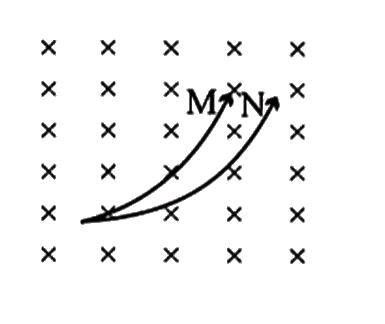An electron and a proton are projected with same velocity perpendicular to a magnetic field.
(a) Which particle will describe the smaller circle?
(b) Which particle will have greater frequency?
a.r=mvBq
or r∝m as other factors are same
b. f=Bq2πm
or f∝1m
Topper's Solved these Questions
- MAGNETICSBOOK - DC PANDEYCHAPTER - MAGNETICSEXERCISE - INTRODUCTORY EXERCISE
1 Video
- MAGNETICSBOOK - DC PANDEYCHAPTER - MAGNETICSEXERCISE - SUBJECTIVE_TYPE
1 Video
- MAGNETICSBOOK - DC PANDEYCHAPTER - MAGNETICSEXERCISE - MCQ_TYPE
1 Video
- MAGNETIC FIELD AND FORCESBOOK - DC PANDEYCHAPTER - MAGNETIC FIELD AND FORCESEXERCISE - Medical entrance s gallery
59 Videos
- MAGNETISM AND MATTERBOOK - DC PANDEYCHAPTER - MAGNETISM AND MATTEREXERCISE - Medical gallery
1 Video
Similar Questions
Knowledge Check
If an electron and a proton having same momenta enter perpendicular to a magnetic field, then
Acurved path of electron and proton will be same ( ignoring the sense of revolution)Bthey will move undeflectedCcurved path of electron is more curved than that of the protonDpath of proton is more curved.Which particle will have minimum frequency of revolution when projected with the same velocity perpendicular to a magnetic field ?
ALi+BElectronCProtonDHe+If a charged particle (+q) is projected with certain velocity parallel to the magnetic field , then it will
Atrace helical pathBtrace circular pathCcontinue its motion without any changeDcome to rest instantly
Electron, proton, He+ and Li+ are projected with the same speed perpendicular to a uniform magnetic field. Which particle will experience the maximum magnetic force?
View SolutionA particle is projected in a plane perpendicular to a uniform magnetic field. The area bounded by the path described by the particle is proportional to
View SolutionTwo charged particle M and N are projected with same velocity in a uniform magnetic field. Then M and N respectively.

View SolutionWhich on the following will describe the smallest circle when projected with the same velocity v perpendicular to the magnetic field B: (i)α -particle (ii) β-particle?
View SolutionAn electron and an alpha particle having equal velocities pass at right angles to the magnetic field.In this field
View Solution